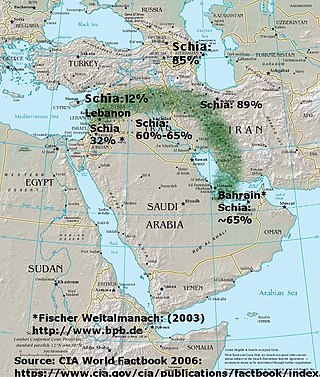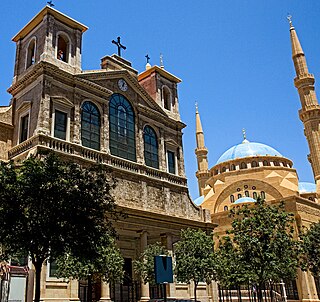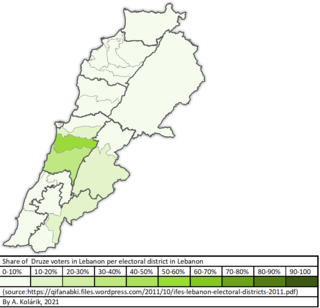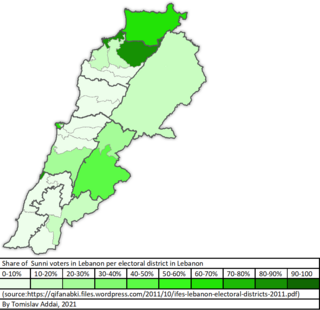
The Druze, who call themselves al-Muwaḥḥidūn, are an Arab and Arabic-speaking esoteric ethnoreligious group from Western Asia who adhere to the Druze faith, an Abrahamic, monotheistic, syncretic, and ethnic religion whose main tenets are the unity of God and the belief in reincarnation and the eternity of the soul. Most Druze religious practices are kept secret. The Druze do not permit outsiders to convert to their religion. Marriage outside the Druze faith is rare and strongly discouraged.

Jordan has a population of more than 11.1 million inhabitants as of 2023. Jordanians are the citizens of Jordan. Around 94% of Jordanians are Arabs, while the remaining 6% belong to other ethnic minorities, including Circassians, Chechens, Armenians and Kurds. Around 2.9 million inhabitants are non-citizens, a figure including refugees, legal and illegal immigrants. Jordan's annual population growth rate stands at 3.05% as of 2023, with an average of 2.8 births per woman. There were 1,977,534 households in Jordan in 2015, with an average of 4.8 persons per household.

This is a demography of the population of Lebanon including population density, education level, health of the populace, economic status, religious affiliations and other aspects of the population.

The Alawites, also known as Nusayrites, are an ethnoreligious group that live primarily in the Levant and follow Alawism, a religious sect that splintered from early Shi'ism as a ghulat branch during the ninth century. Alawites venerate Ali ibn Abi Talib, revered as the first Imam in the Twelver school, as the physical manifestation of God. The group was founded by Ibn Nusayr during the 9th century. Ibn Nusayr was a disciple of the tenth Twelver Imam, Ali al-Hadi and of the eleventh Twelver Imam, Hasan al-Askari. For this reason, Alawites are also called Nusayris.

The Hashemite Kingdom of Jordan is a majority Muslim country with 96% of the population following Sunni Islam while a small minority follow Shiite branches. There are also about 20,000 to 32,000 Druze living mostly in the north of Jordan, even though most Druze no longer consider themselves Muslim. Many Jordanian Muslims practice Sufism.

The Lebanese people are the people inhabiting or originating from Lebanon. The term may also include those who had inhabited Mount Lebanon and the Anti-Lebanon Mountains prior to the creation of the modern Lebanese state. The major religious groups among the Lebanese people within Lebanon are Shia Muslims (27%), Sunni Muslims (27%), Maronite Christians (21%), Greek Orthodox Christians (8%), Melkite Christians (5%), Druze (5.2%), Protestant Christians (1%). The largest contingent of Lebanese, however, comprise a diaspora in North America, South America, Europe, Australia and Africa, which is predominantly Maronite Christian.

Several different denominations and sects of Islam are practised within Syria, whom collectively, constitute approximately 87% of the population and form a majority in most of the districts of the country.

The Shia Crescent is the notionally crescent-shaped region of the Middle East where the majority population is Shia or where there is a strong Shia minority in the population.
Islam is historically divided into two major sects, Sunni and Shia Islam, each with its own sub-sects. Large numbers of Shia Arab Muslims live in some Arab countries including Lebanon, Yemen, Bahrain, Iraq, Saudi Arabia, Kuwait, Oman, the UAE, and Qatar.

Lebanon is an eastern Mediterranean country that has the most religiously diverse society within the Middle East, comprising 18 recognized religious sects. The religions are Islam and Christianity. The Druze comprise around 5% of Lebanon's population.
For approximately a millennium, the Abrahamic religions have been predominant throughout all of the Middle East. The Abrahamic tradition itself and the three best-known Abrahamic religions originate from the Middle East: Judaism and Christianity emerged in the Levant in the 6th century BCE and the 1st century CE, respectively, while Islam emerged in Arabia in the 7th century CE.
Religion in Syria refers to the range of religions practiced by the citizens of Syria. Historically, the region has been a mosaic of diverse faiths with a range of different sects within each of these religious communities.
The Lebanese Constitution provides for freedom of religion and creeds and the exercise of all religious rites provided that the public order is not disturbed. The Constitution declares equality of rights and duties for all citizens without discrimination or preference but establishes a balance of power among the major religious groups. The government has generally respected these rights; however, the National Pact agreement in 1943 restricted the constitutional provision for apportioning political offices according to religious affiliation. There have been periodic reports of tension between religious groups, attributable to competition for political power, and citizens continue to struggle with the legacy of the civil war that was fought along sectarian lines. Despite sectarian tensions caused by the competition for political power, the Lebanese continue to coexist.

The Lebanese Druze are an ethnoreligious group constituting about 5.2 percent of the population of Lebanon. They follow the Druze faith, which is an esoteric Abrahamic religion originating from the Near East, and self identify as unitarians.

Lebanese Shia Muslims, communally and historically known as matāwila, are Lebanese people who are adherents of Shia Islam in Lebanon, which plays a major role alongside Lebanon's main Sunni, Maronite and Druze sects. The vast majority of Shia Muslims in Lebanon adhere to Twelver Shi'ism, making them the primary Twelver Shia community in the Levant.

Lebanese Sunni Muslims are Lebanese people who are adherents of the Sunni branch of Islam in Lebanon, which is one of the largest denomination in Lebanon tied with Shias. Sunni Islam in Lebanon has a history of more than a millennium. According to a CIA 2018 study, Lebanese Sunni Muslims constitute an estimated 30.6% of Lebanon's population.

Druze in Syria is a significant minority religion. According to The World Factbook, Druze make up about 3.2 percent of the population of Syria, or approximately 700,000 persons, including residents of the Golan Heights. The Druzites are concentrated in the rural, mountainous areas east and south of Damascus in the area known officially as the Jabal al-Druze.
Druze in Jordan refers to adherents of the Druze faith, an ethnoreligious esoteric group originating from the Near East who self identify as unitarians (Muwahhideen). Druze faith is a monotheistic and Abrahamic religion, and Druze do not identify as Muslims.

Shia Islam is practiced by a minority of Muslims in the United Arab Emirates. It is also practiced among expatriate Muslim communities living in the country, most notably Iranians, as well as some Arabs, Pakistanis, Indians, and other nationalities. Non-Twelver Shia branches such as Ismailis and the Dawoodi Bohras are also present in the UAE and account for less than 5% of the total population. Shia nationals are concentrated in the city of Dubai, belonging mostly to the latest (1920s) wave of migrants who managed to obtain citizenship.
The Kisrawan campaigns were a series of Mamluk military expeditions against the mountaineers of the Kisrawan, as well as the neighboring areas of Byblos and the Jurd, in Mount Lebanon. The offensives were launched in 1292, 1300 and 1305. The mountaineers were Shia Muslim, Alawite, Maronite and Druze tribesmen who historically acted autonomously of any central authority. The Maronites in particular had maintained close cooperation with the last Crusader state, the County of Tripoli. After the fall of Tripoli to the Mamluks in 1289, the mountaineers would often block the coastal road between Tripoli and Beirut, prompting the first Mamluk expedition in 1292 under the viceroy of Egypt, Baydara. During that campaign, the Mamluks, spread along the coastal road and cut off from each other at various points, were constantly harried by the mountaineers, who confiscated their weapons, horses and money. Baydara withdrew his men only after paying off the mountain chiefs.

















